An Automatic Geometric Registration Method for Multi Temporal 3D Models
Abstract
1. Introduction
2. Study Area and Data
2.1. Study Area
2.2. Data Acquisition
3. Methodology
- (1)
- The 3D model feature points are extracted from the texture image by the interest point operator, and their position information is computed.
- (2)
- The feature vector of spatial-feature points consists of the image information around the feature points, which are used to match the corresponding points.
- (3)
- According to the corresponding position of the spatial-feature points, the transformation model parameters between models are estimated, than the new transformation model is used to update the spatial location information of the 3D model to be registered.
3.1. Spatial-Feature-Point Extraction
3.2. Spatial-Feature-Point Matching
3.3. Registration Model Solution
3.4. Data Processing
4. Experiment Results and Discussions
4.1. Distribution and Correspondence Analysis of Spatial-Feature Points
4.2. Geometric-Registration-Accuracy Analysis of Spatial-Feature Points
4.3. Accuracy Analysis of 3D Model after Registration
5. Conclusions
Author Contributions
Funding
Institutional Review Board Statement
Informed Consent Statement
Data Availability Statement
Conflicts of Interest
References
- Mathews, A.J. A practical UAV remote sensing methodology to generate multispectral orthophotos for vineyards: Estimation of spectral reflectance using compact digital cameras. Int. J. Appl. Geospat. Res. 2015, 6, 65–87. [Google Scholar] [CrossRef]
- Lu, P.; Catani, F.; Tofani, V.; Casagli, N. Quantitative hazard and risk assessment for slow-moving landslides from Persistent Scatterer Interferometry. Landslides 2014, 11, 685–696. [Google Scholar] [CrossRef]
- Abdulla, A.R.; He, F.; Adel, M.; Naser, E.S.; Ayman, H. Using an unmanned aerial vehicle-based digital imaging system to derive a 3D point cloud for landslide scarp recognition. Remote Sens. 2016, 8, 95. [Google Scholar] [CrossRef]
- Conforti, M.; Mercuri, M.; Borrelli, L. Morphological changes detection of a large earthflow using archived images, LiDAR-derived DTM, and UAV-based remote sensing. Remote Sens. 2020, 13, 120. [Google Scholar] [CrossRef]
- Komarek, J.; Klouček, T.; Prošek, J. The potential of Unmanned Aerial Systems: A tool towards precision classification of hard-to-distinguish vegetation types? Int. J. Appl. Earth Obs. Geoinf. 2018, 71, 9–19. [Google Scholar] [CrossRef]
- Klouek, T.; Komárek, J.; Surov, P.; Hrach, K.; Vaíek, B. The use of UAV mounted sensors for precise detection of bark beetle infestation. Remote Sens. 2019, 11, 1561. [Google Scholar] [CrossRef]
- Castilla, F.J.; Ramón, A.; Adán, A.; Trenado, A.; Fuentes, D. 3D sensor-fusion for the documentation of rural heritage buildings. Remote Sens. 2021, 13, 1337. [Google Scholar] [CrossRef]
- Lucieer, A.; Jong, S.; Turner, D. Mapping landslide displacements using structure from motion (SfM) and image correlation of multi-temporal UAV photography. Prog. Phys. Geogr. 2014, 38, 97–116. [Google Scholar] [CrossRef]
- Guzzetti, F.; Mondini, A.C.; Cardinali, M.; Fiorucci, F.; Santangelo, M.; Chang, K.T. Landslide inventory maps: New tools for an old problem. Earth-Sci. Rev. 2012, 112, 42–66. [Google Scholar] [CrossRef]
- Ewertowski, M.; Tomczyk, A.; Evans, D.; Roberts, D.; Ewertowski, W. Operational framework for rapid, very-high resolution mapping of glacial geomorphology using low-cost unmanned aerial vehicles and structure-from-motion approach. Remote Sens. 2019, 11, 65. [Google Scholar] [CrossRef]
- Rakha, T.; Gorodetsky, A. Review of unmanned aerial system (UAS) applications in the built environment: Towards automated building inspection procedures using drones. Autom. Constr. 2018, 93, 252–264. [Google Scholar] [CrossRef]
- Kohv, M.; Sepp, E.; Vammus, L. Assessing multitemporal water-level changes with uav-based photogrammetry. Photogramm. Rec. 2017, 32, 424–442. [Google Scholar] [CrossRef]
- Huang, F.; Yang, H.; Tan, X.; Peng, S.; Tao, J.; Peng, S. Fast reconstruction of 3D point cloud model using visual SLAM on embedded UAV development platform. Remote Sens. 2020, 12, 3308. [Google Scholar] [CrossRef]
- Smith, M.; Carrivick, J.; Quincey, D. Structure from motion photogrammetry in physical geography. Prog. Phys. Geogr. 2015, 40, 247–275. [Google Scholar] [CrossRef]
- Westoby, M.J.; Brasington, J.; Glasser, N.F.; Hambrey, M.J.; Reynolds, J.M. ‘Structure-from-Motion’ photogrammetry: A low-cost, effective tool for geoscience applications. Geomorphology 2012, 179, 300–314. [Google Scholar] [CrossRef]
- Stathopoulou, E.K.; Welponer, M.; Remondino, F. Open-source image-based 3D reconstruction pipelines: Review, comparision and evaluation. ISPRS-Int. Arch. Photogramm. Remote Sens. Spat. Inf. Sci. 2019, XLII-2/W, 331–338. [Google Scholar] [CrossRef]
- Ren, C.; Zhi, X.; Pu, Y.; Zhang, F. A multi-scale UAV image matching method applied to large-scale landslide reconstruction. Math. Biosci. Eng. 2021, 18, 2274–2287. [Google Scholar] [CrossRef]
- Le, V.C.; Cao, X.C.; Long, N.Q.; Le, T.; Anh, T.T.; Bui, X.N. Experimental investigation on the performance of DJI Phantom 4 RTK in the PPK Mode for 3D mapping open-pit mines. Inz. Miner. 2020, 1, 65–74. [Google Scholar]
- Long, N.; Goyal, R.; Bui, L.; Cao, C.; Canh, L.; Quang Minh, N.; Bui, X.-N. Optimal choice of the number of ground control points for developing precise DSM using light-weight UAV in small and medium-sized open-pit mine. Arch. Min. Sci. 2021, 66, 369–384. [Google Scholar]
- Ren, C.; Shang, H.; Zha, Z.; Zhang, F.; Pu, Y. Color balance method of dense point cloud in landslides area based on UAV images. IEEE Sens. J. 2022, 22, 3516–3528. [Google Scholar] [CrossRef]
- Troner, M.; Urban, R.; Seidl, J.; Reindl, T.; Brouek, J. Photogrammetry using UAV-mounted GNSS RTK: Georeferencing strategies without GCPs. Remote Sens. 2021, 13, 1336. [Google Scholar] [CrossRef]
- Gong, Y.; Meng, D.; Seibel, E.J. Bound constrained bundle adjustment for reliable 3D reconstruction. Opt. Express 2015, 23, 10771–10785. [Google Scholar] [CrossRef] [PubMed]
- Triggs, B. Bundle Adjustment—A modern synthesis. In Proceedings of International Workshop on Vision Algorithms: Theory & Practice; Springer: Berlin/Heidelberg, Germany, 1999; pp. 298–372. [Google Scholar]
- Troner, M.; Urban, R.; Reindl, T.; Seidl, J.; Brouek, J. Evaluation of the georeferencing accuracy of a photogrammetric model using a quadrocopter with onboard GNSS RTK. Sensors 2020, 20, 2318. [Google Scholar] [CrossRef]
- Taddia, Y.; Stecchi, F.; Pellegrinelli, A. Coastal mapping using DJI Phantom 4 RTK in post-processing kinematic mode. Drones 2020, 4, 9. [Google Scholar] [CrossRef]
- Corominas, J.; Westen, C.V.; Frattini, P.; Cascini, L.; Smith, J.T. Recommendations for the quantitative analysis of landslide risk. Bull. Eng. Geol. Environ. 2014, 73, 209–263. [Google Scholar] [CrossRef]
- James, M.R.; Robson, S.; D"Oleire-Oltmanns, S.; Niethammer, U. Optimising UAV topographic surveys processed with structure-from-motion: Ground control quality, quantity and bundle adjustment. Geomorphology 2017, 280, 51–66. [Google Scholar] [CrossRef]
- Lowe, D. Distinctive image features from scale-invariant key points. Int. J. Comput. Vis. 2003, 60, 91–110. [Google Scholar] [CrossRef]
- Nocedal, J.; Wright, S.J.; Mikosch, T.V.; Resnick, S.I.; Robinson, S.M. Numerical Optimization; Springer: Berlin/Heidelberg, Germany, 1999. [Google Scholar]
- Levmar: Levenberg-Marquardt Nonlinear Least Squares Algorithms in C/C++. Available online: http://users.ics.forth.gr/~lourakis/levmar/ (accessed on 22 October 2020).
- Fischler, M.A.; Bolles, R.C. Random sample consensus: A paradigm for model fitting with applications to image analysis and automated cartography. Read. Comput. Vis. 1981, 24, 381–395. [Google Scholar] [CrossRef]
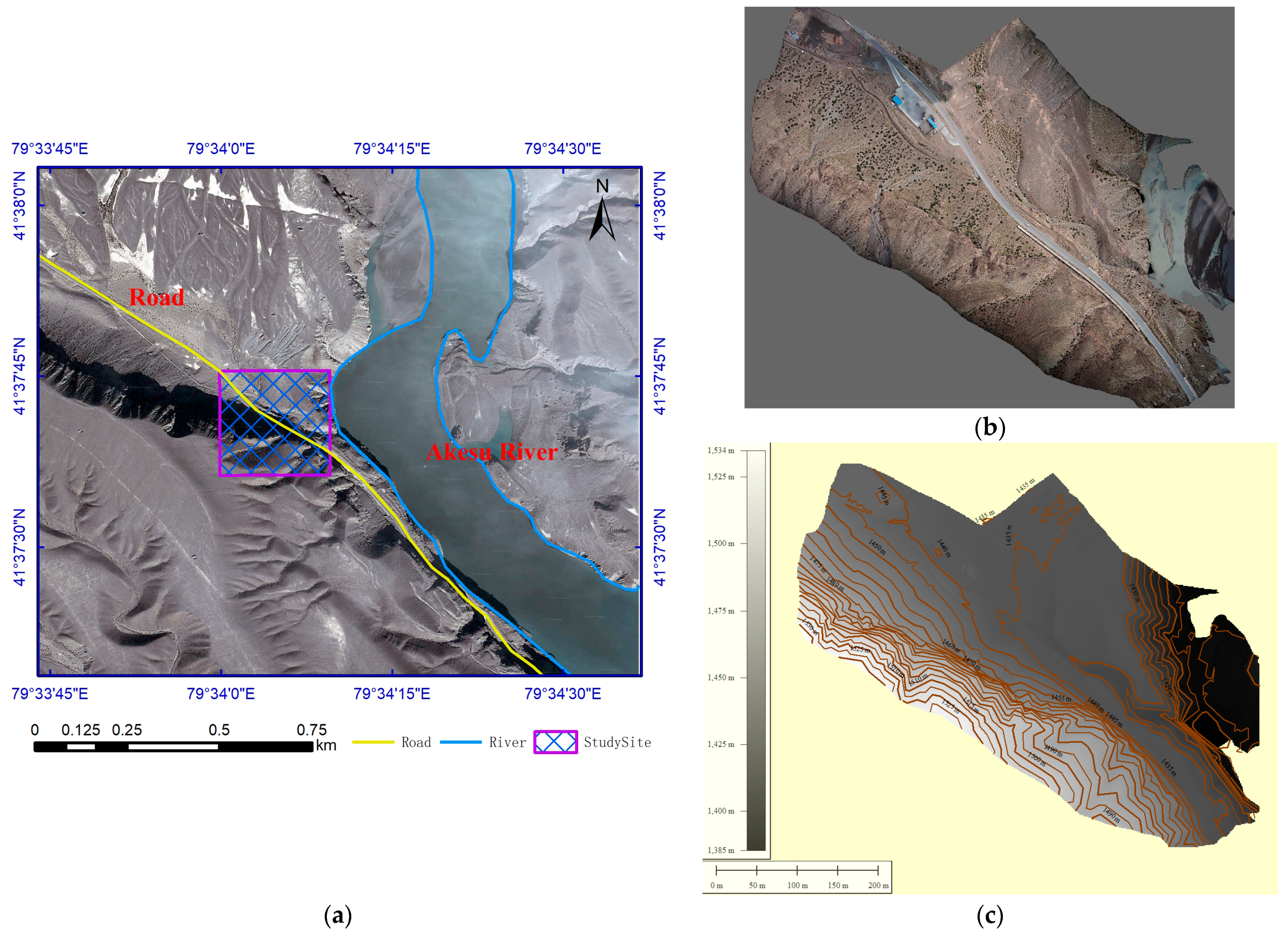
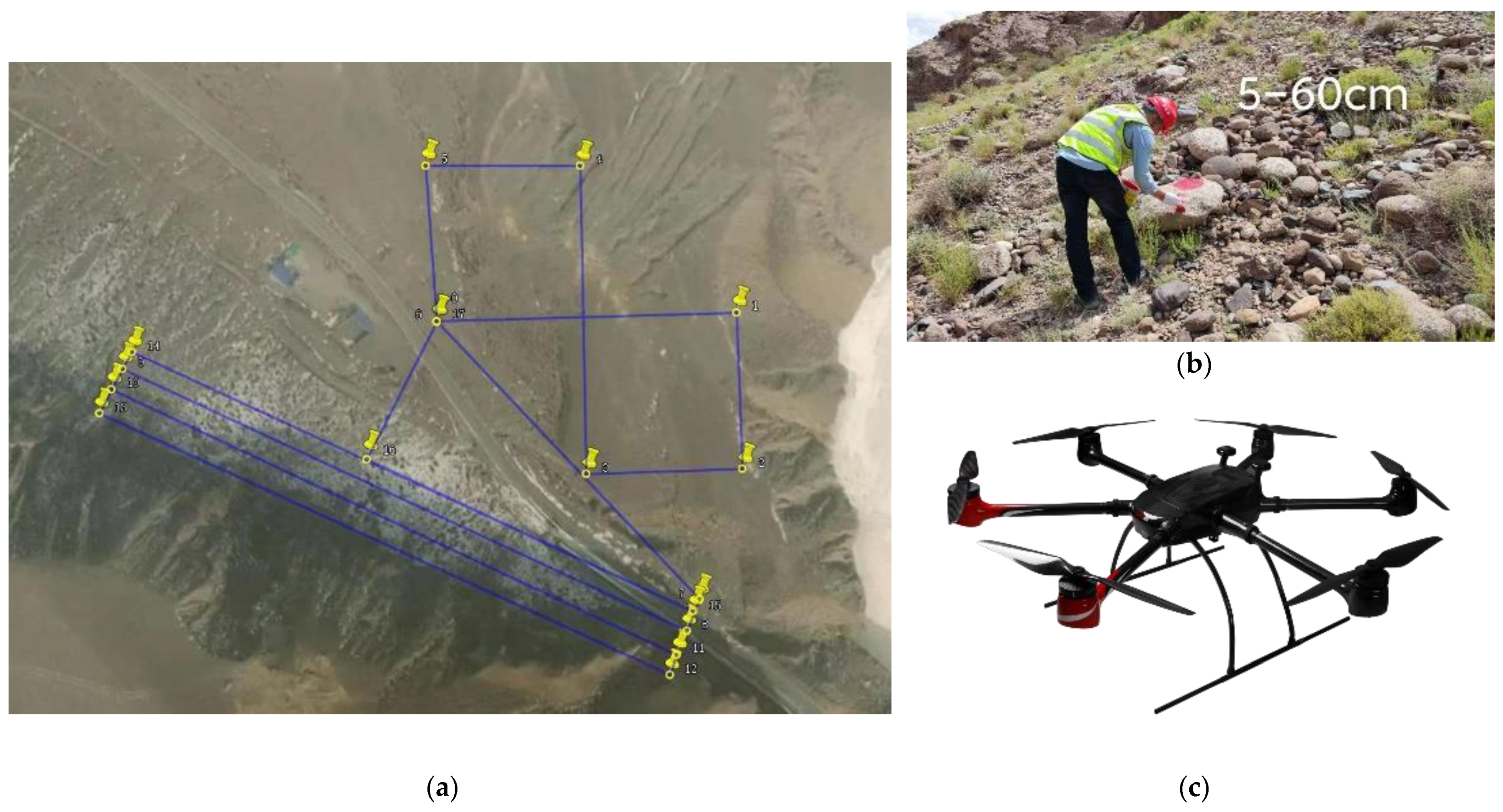
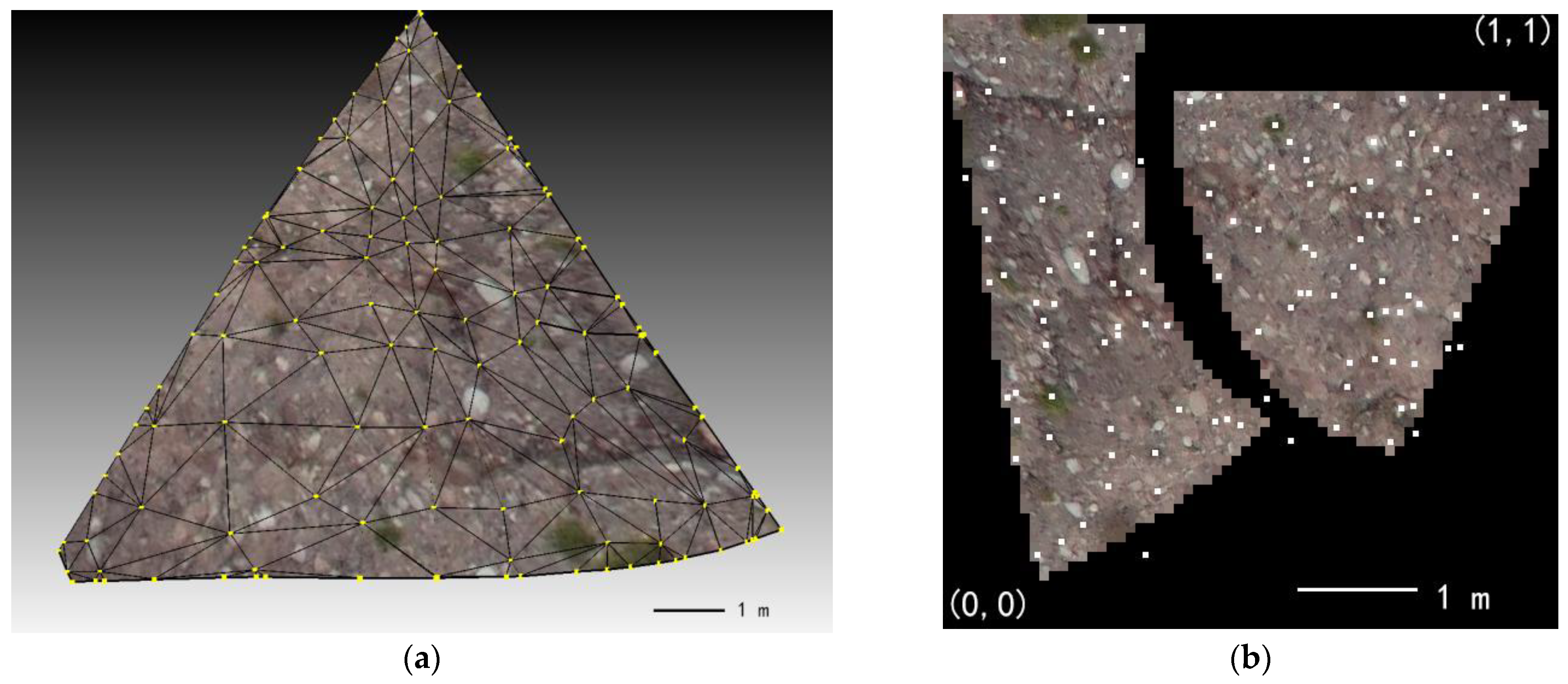
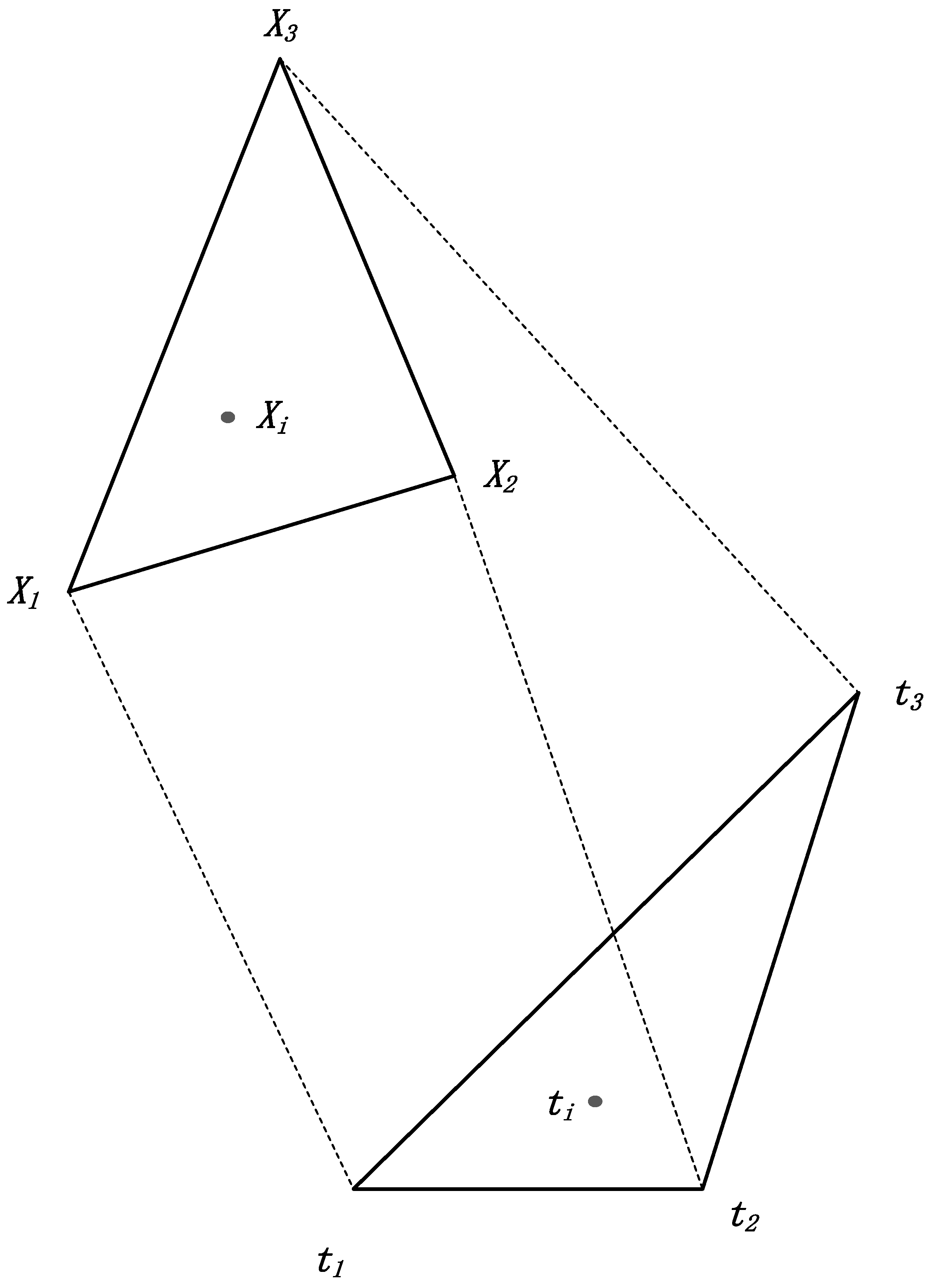
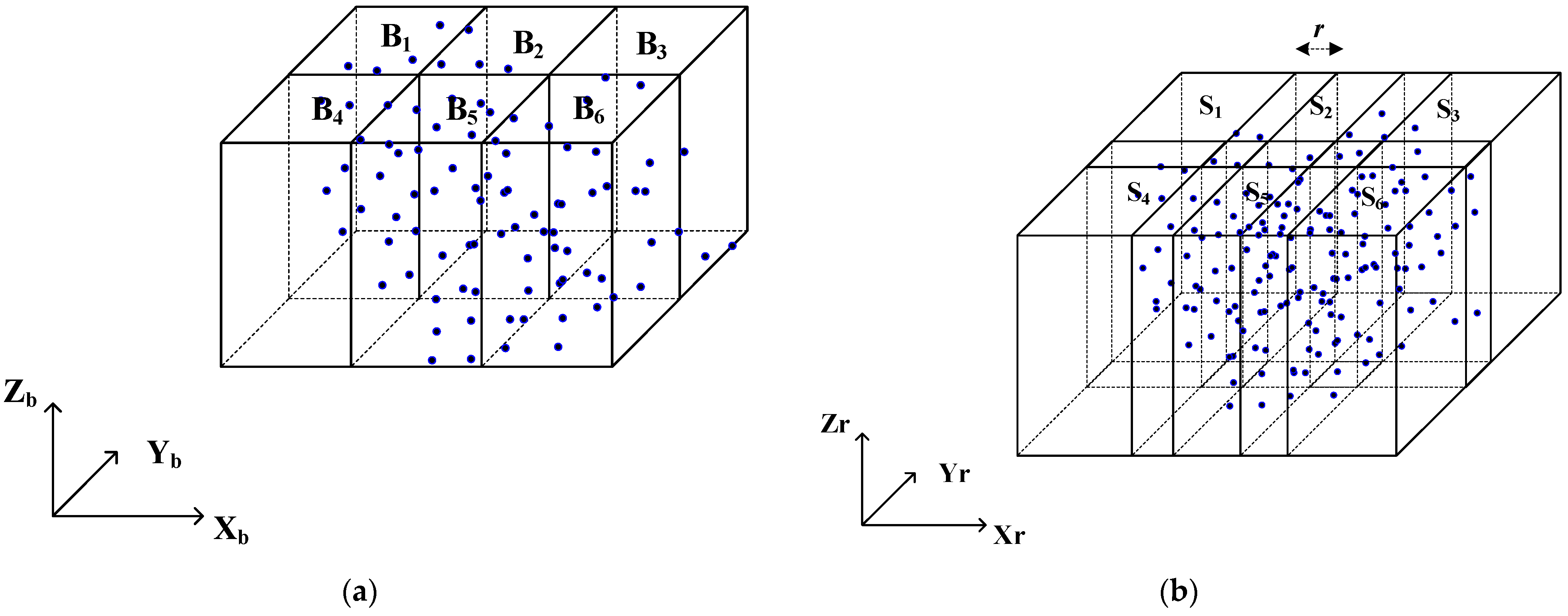
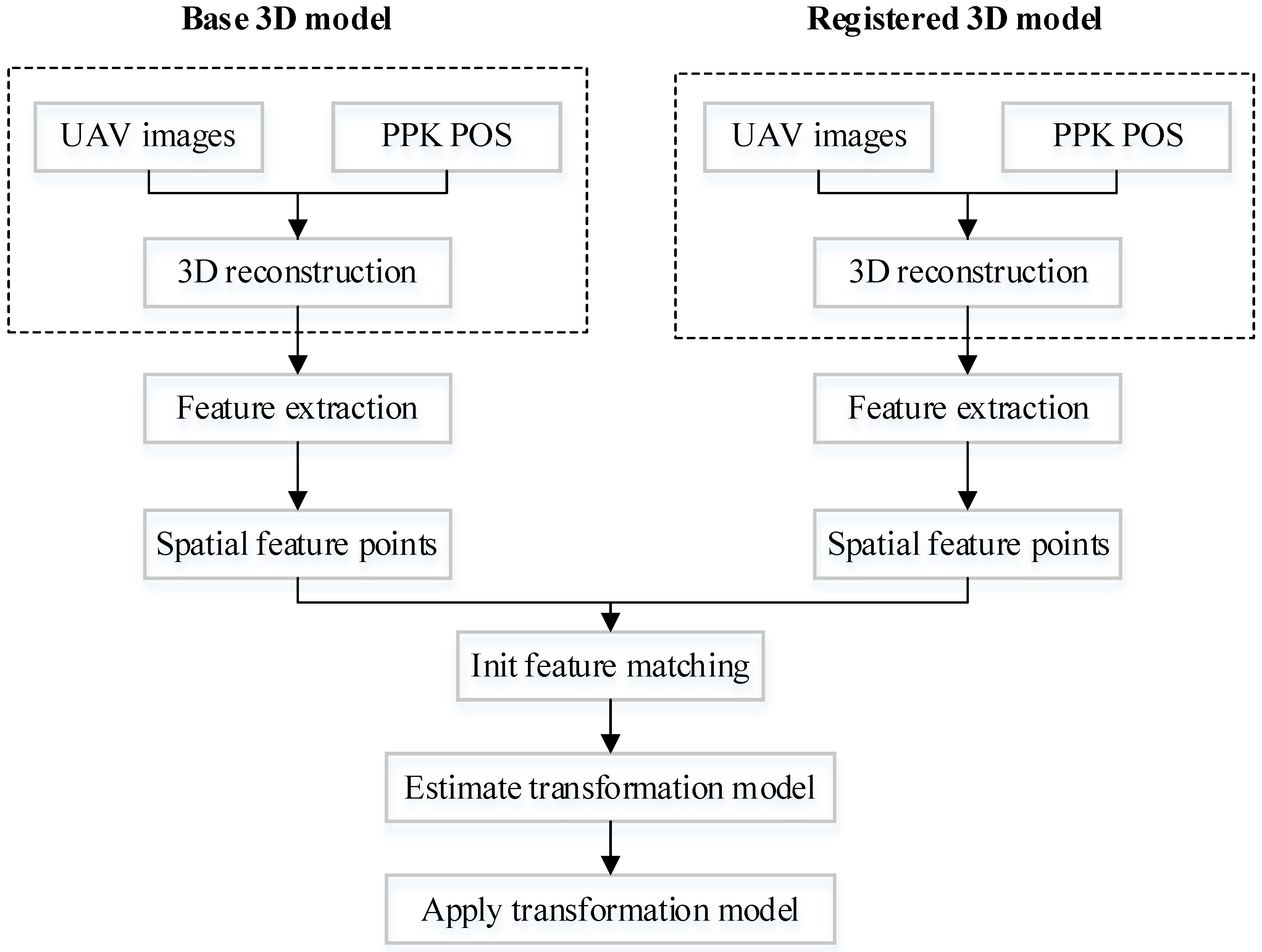

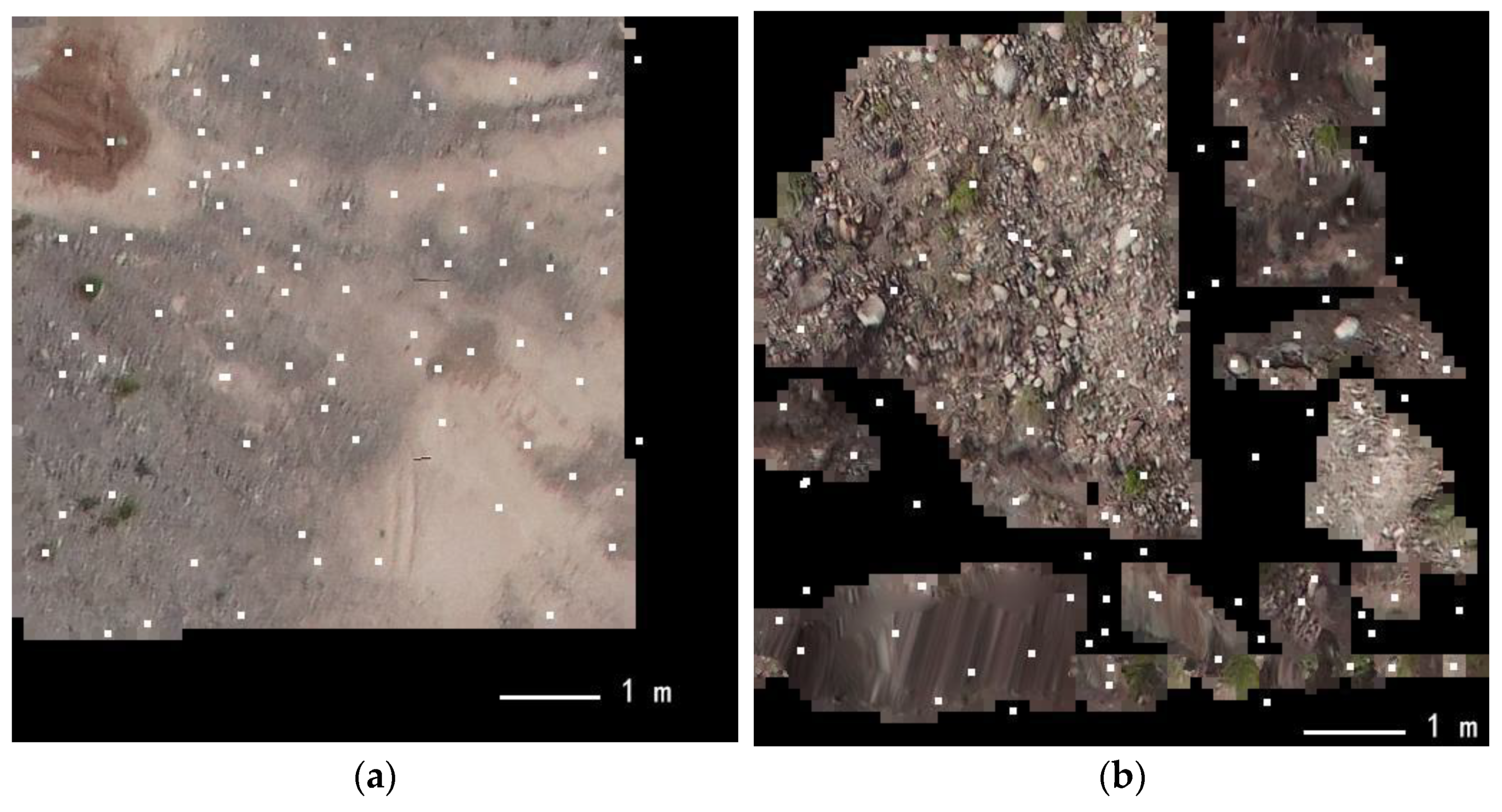
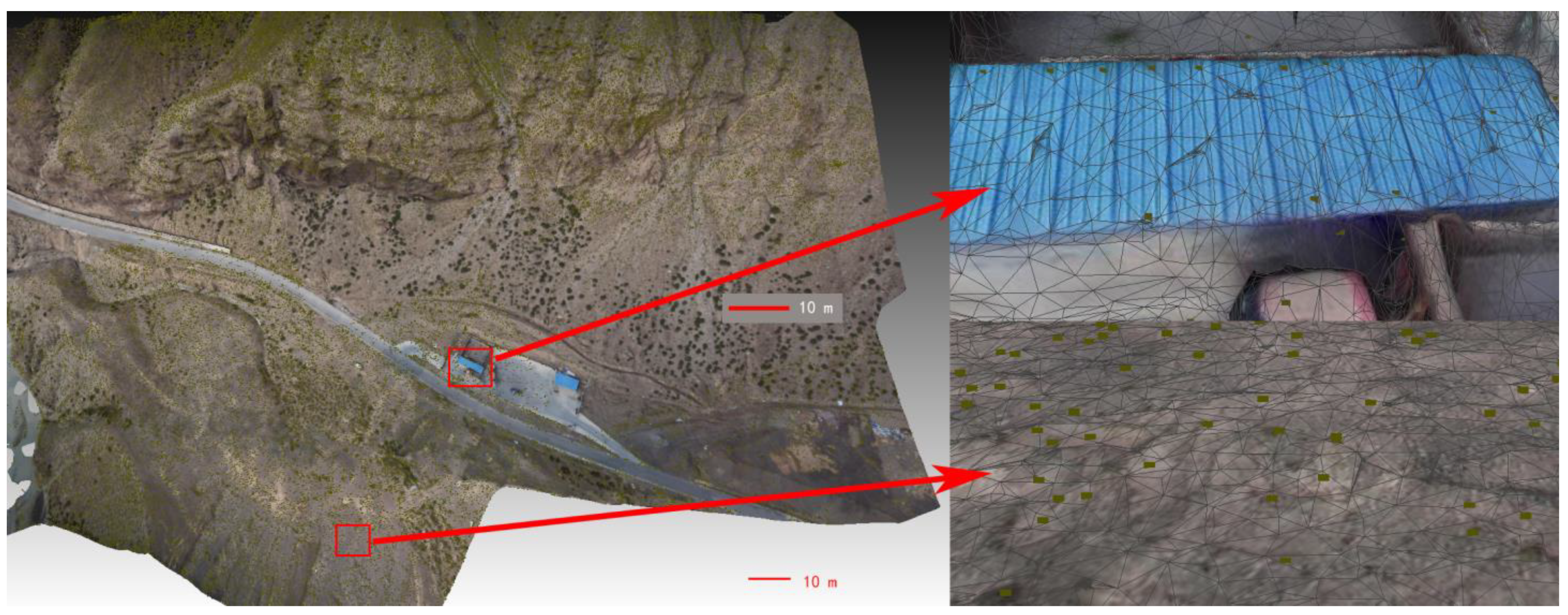
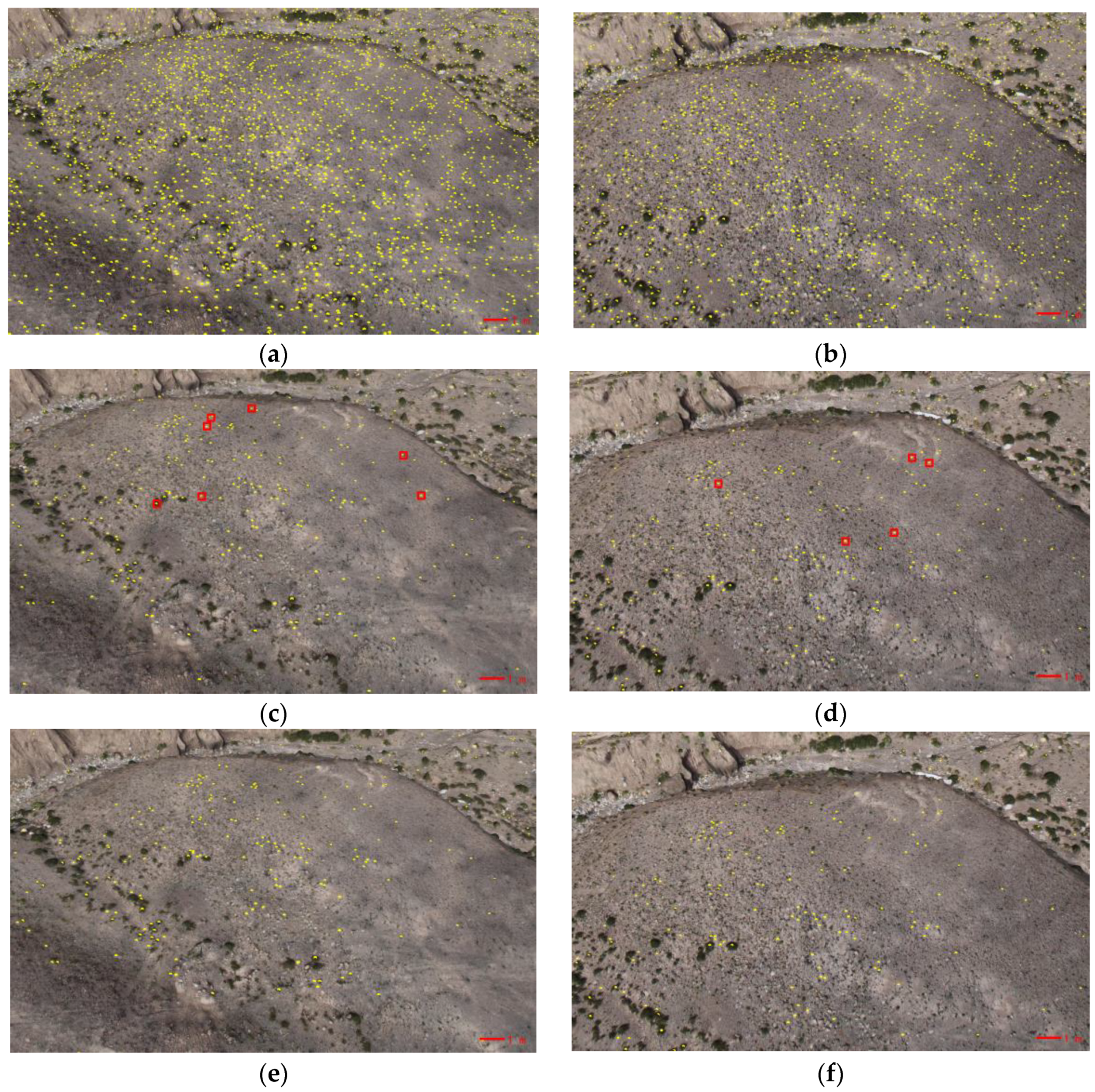
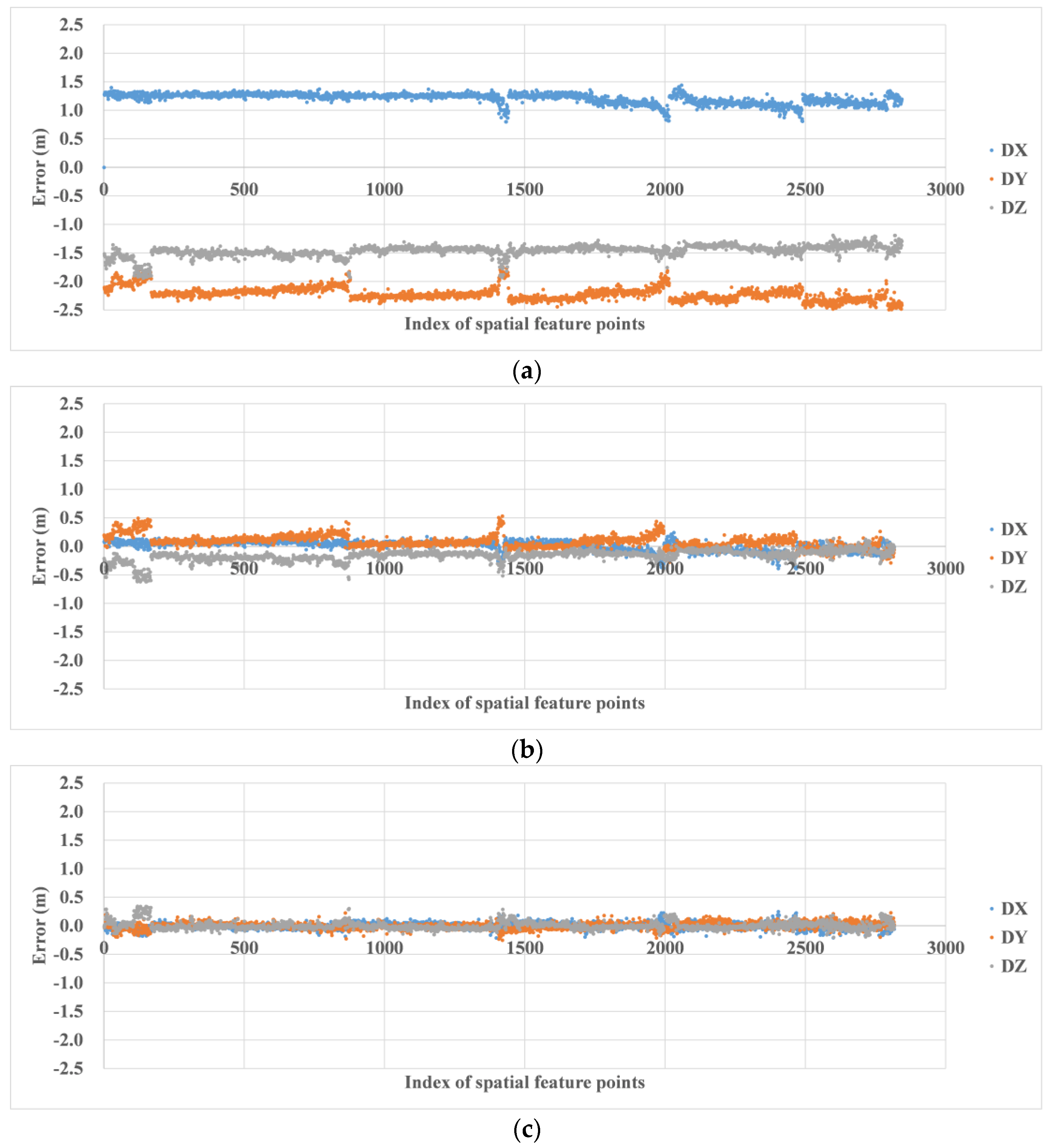
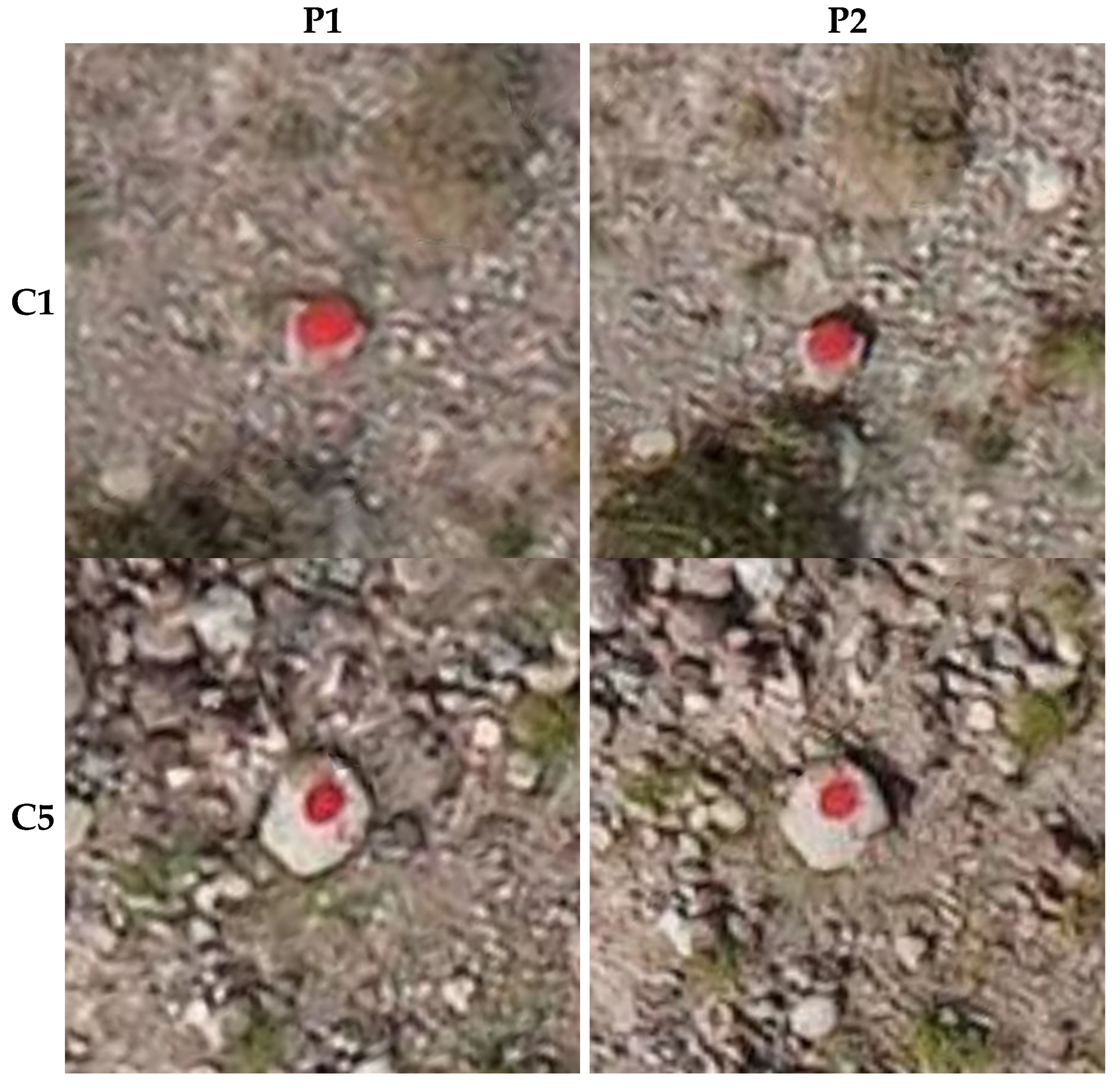
| Hovering Time (min) | Load Capacity (kg) | Maximum Working Altitude (m) | Sensor Size (pixel) | Focal Length (mm) | Pixel Size (mm) |
|---|---|---|---|---|---|
| 75 | 15 | 5000 | 9504 × 6336 | 25 | 0.0037 |
| Method | AVG X (m) | AVG Y (m) | AVG Z (m) | STD X (m) | STD Y (m) | STD Z (m) |
|---|---|---|---|---|---|---|
| POS | 1.21 | −2.21 | −1.46 | 0.12 | 0.12 | 0.13 |
| PPK | 0.01 | 0.08 | −0.16 | 0.09 | 0.11 | 0.09 |
| REG | 5.37 × 10−5 | −2.38 × 10−5 | 7.10 × 10−7 | 0.05 | 0.06 | 0.07 |
| Name | Displacement (m) | Difference (m) | |||||
|---|---|---|---|---|---|---|---|
| GPS | POS | PPK | REG | POS | PPK | REG | |
| C1 | 0.49 | 3.13 | 0.41 | 0.49 | −2.64 | 0.07 | −0.01 |
| C2 | 0.62 | 2.87 | 0.58 | 0.61 | −2.25 | 0.04 | 0.01 |
| C3 | 0.88 | 3.03 | 0.83 | 0.87 | −2.15 | 0.06 | 0.01 |
| C4 | 0.63 | 3.14 | 0.53 | 0.61 | −2.51 | 0.10 | 0.02 |
| C5 | 0.37 | 2.97 | 0.24 | 0.33 | −2.61 | 0.13 | 0.04 |
| C6 | 0.73 | 3.20 | 0.69 | 0.77 | −2.46 | 0.04 | −0.04 |
| C7 | 0.47 | 3.14 | 0.34 | 0.45 | −2.67 | 0.13 | 0.02 |
| AVG | - | −2.47 | 0.08 | 0.01 | |||
Publisher’s Note: MDPI stays neutral with regard to jurisdictional claims in published maps and institutional affiliations. |
© 2022 by the authors. Licensee MDPI, Basel, Switzerland. This article is an open access article distributed under the terms and conditions of the Creative Commons Attribution (CC BY) license (https://creativecommons.org/licenses/by/4.0/).
Share and Cite
Shang, H.; Ju, G.; Li, G.; Li, Z.; Ren, C. An Automatic Geometric Registration Method for Multi Temporal 3D Models. Appl. Sci. 2022, 12, 11070. https://doi.org/10.3390/app122111070
Shang H, Ju G, Li G, Li Z, Ren C. An Automatic Geometric Registration Method for Multi Temporal 3D Models. Applied Sciences. 2022; 12(21):11070. https://doi.org/10.3390/app122111070
Chicago/Turabian StyleShang, Haixing, Guanghong Ju, Guilin Li, Zufeng Li, and Chaofeng Ren. 2022. "An Automatic Geometric Registration Method for Multi Temporal 3D Models" Applied Sciences 12, no. 21: 11070. https://doi.org/10.3390/app122111070
APA StyleShang, H., Ju, G., Li, G., Li, Z., & Ren, C. (2022). An Automatic Geometric Registration Method for Multi Temporal 3D Models. Applied Sciences, 12(21), 11070. https://doi.org/10.3390/app122111070





